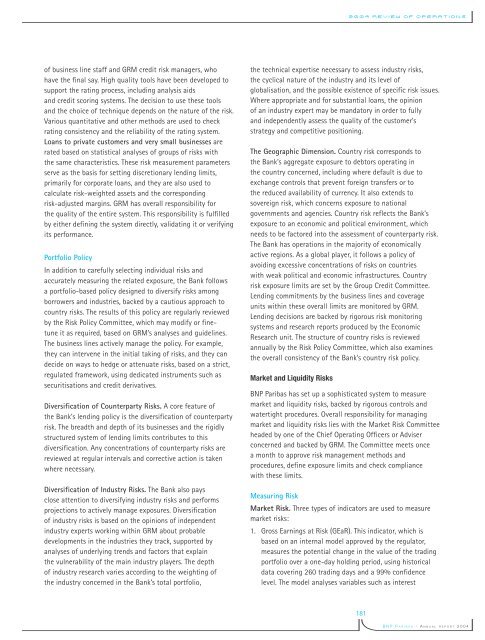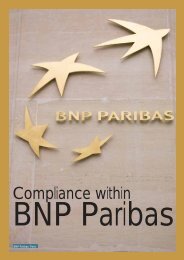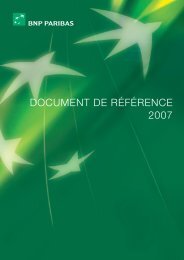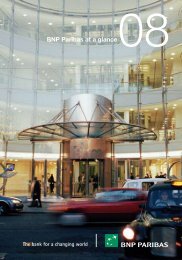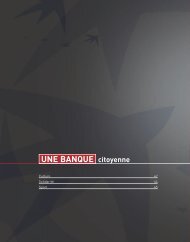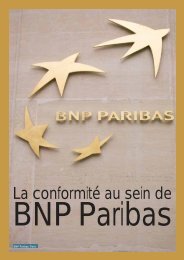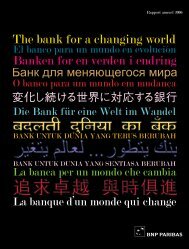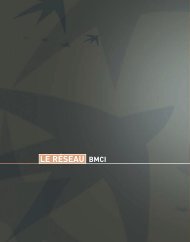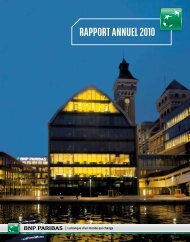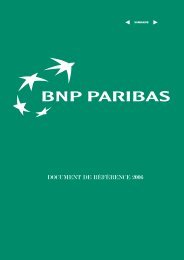La banque d'un monde qui change 2004 - BNP Paribas
La banque d'un monde qui change 2004 - BNP Paribas
La banque d'un monde qui change 2004 - BNP Paribas
You also want an ePaper? Increase the reach of your titles
YUMPU automatically turns print PDFs into web optimized ePapers that Google loves.
<strong>2004</strong> Review of Operationsof business line staff and GRM credit risk managers, whohave the final say. High quality tools have been developed tosupport the rating process, including analysis aidsand credit scoring systems. The decision to use these toolsand the choice of technique depends on the nature of the risk.Various quantitative and other methods are used to checkrating consistency and the reliability of the rating system.Loans to private customers and very small businesses arerated based on statistical analyses of groups of risks withthe same characteristics. These risk measurement parametersserve as the basis for setting discretionary lending limits,primarily for corporate loans, and they are also used tocalculate risk-weighted assets and the correspondingrisk-adjusted margins. GRM has overall responsibility forthe quality of the entire system. This responsibility is fulfilledby either defining the system directly, validating it or verifyingits performance.Portfolio PolicyIn addition to carefully selecting individual risks andaccurately measuring the related exposure, the Bank followsa portfolio-based policy designed to diversify risks amongborrowers and industries, backed by a cautious approach tocountry risks. The results of this policy are regularly reviewedby the Risk Policy Committee, which may modify or finetuneit as re<strong>qui</strong>red, based on GRM’s analyses and guidelines.The business lines actively manage the policy. For example,they can intervene in the initial taking of risks, and they candecide on ways to hedge or attenuate risks, based on a strict,regulated framework, using dedicated instruments such assecuritisations and credit derivatives.Diversification of Counterparty Risks. A core feature ofthe Bank’s lending policy is the diversification of counterpartyrisk. The breadth and depth of its businesses and the rigidlystructured system of lending limits contributes to thisdiversification. Any concentrations of counterparty risks arereviewed at regular intervals and corrective action is takenwhere necessary.Diversification of Industry Risks. The Bank also paysclose attention to diversifying industry risks and performsprojections to actively manage exposures. Diversificationof industry risks is based on the opinions of independentindustry experts working within GRM about probabledevelopments in the industries they track, supported byanalyses of underlying trends and factors that explainthe vulnerability of the main industry players. The depthof industry research varies according to the weighting ofthe industry concerned in the Bank’s total portfolio,the technical expertise necessary to assess industry risks,the cyclical nature of the industry and its level ofglobalisation, and the possible existence of specific risk issues.Where appropriate and for substantial loans, the opinionof an industry expert may be mandatory in order to fullyand independently assess the quality of the customer’sstrategy and competitive positioning.The Geographic Dimension. Country risk corresponds tothe Bank’s aggregate exposure to debtors operating inthe country concerned, including where default is due toex<strong>change</strong> controls that prevent foreign transfers or tothe reduced availability of currency. It also extends tosovereign risk, which concerns exposure to nationalgovernments and agencies. Country risk reflects the Bank’sexposure to an economic and political environment, whichneeds to be factored into the assessment of counterparty risk.The Bank has operations in the majority of economicallyactive regions. As a global player, it follows a policy ofavoiding excessive concentrations of risks on countrieswith weak political and economic infrastructures. Countryrisk exposure limits are set by the Group Credit Committee.Lending commitments by the business lines and coverageunits within these overall limits are monitored by GRM.Lending decisions are backed by rigorous risk monitoringsystems and research reports produced by the EconomicResearch unit. The structure of country risks is reviewedannually by the Risk Policy Committee, which also examinesthe overall consistency of the Bank’s country risk policy.Market and Li<strong>qui</strong>dity Risks<strong>BNP</strong> <strong>Paribas</strong> has set up a sophisticated system to measuremarket and li<strong>qui</strong>dity risks, backed by rigorous controls andwatertight procedures. Overall responsibility for managingmarket and li<strong>qui</strong>dity risks lies with the Market Risk Committeeheaded by one of the Chief Operating Officers or Adviserconcerned and backed by GRM. The Committee meets oncea month to approve risk management methods andprocedures, define exposure limits and check compliancewith these limits.Measuring RiskMarket Risk. Three types of indicators are used to measuremarket risks:1. Gross Earnings at Risk (GEaR). This indicator, which isbased on an internal model approved by the regulator,measures the potential <strong>change</strong> in the value of the tradingportfolio over a one-day holding period, using historicaldata covering 260 trading days and a 99% confidencelevel. The model analyses variables such as interest181<strong>BNP</strong> PARIBAS - ANNUAL REPORT <strong>2004</strong>


